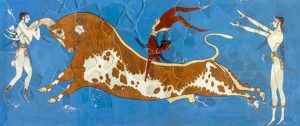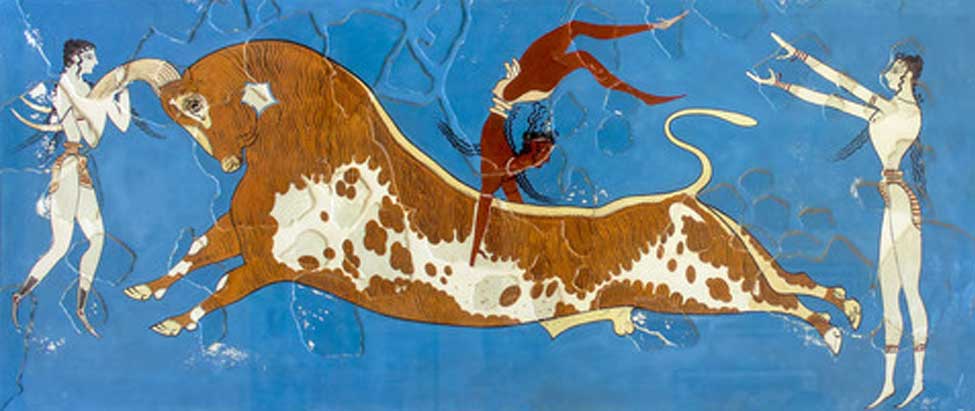History of the Aegean civilization

The location and fertile character of Crete gave it importance in early times. The first high civilization on European soil arose there during the 3d millennium . The impetus for this may have been the introduction of the working of copper and bronze by emigrants from Anatolia or Syria.
Sir Arthur Evans named the Cretan Bronze Age civilization Minoan, for Minos, the legendary king of Knossos, which was the principal Bronze Age center of the island. The Bronze Age of the Cyclades is known as Cycladic; and that of the Greek mainland as Helladic, from Hellas, the ancient name of Greece. The developmental sequences in these areas are divided into Early, Middle, and Late phases, based upon changes of fashion distinguishable chiefly in pottery styles. The term Mycenaean, after the site of Mycenae on the mainland, is often used for the Late Bronze Age there and sometimes for that of the whole Aegean.
The three main phases of the Aegean Bronze Age correspond roughly in time with the Old, Middle, and New Kingdoms in ancient Egypt. Approximate dates for the Aegean Bronze Age are based upon connections with Egypt, supplemented by scientific methods of age determination.
SOURCES OF KNOWLEDGE
Later Greeks were aware of a previous age when iron was unknown and weapons were of bronze, as described by Homer. Their legends preserved some names and vague traditions from this age. Massive Bronze Age defensive walls, such as those at Mycenae and Tiryns, were thought to be the work of giant Cyclopes, but factual information about this Bronze Age has only come from excavations in the past hundred years.
In 1876, Heinrich Schliemann found unplundered royal shaft graves with spectacular gold treasures at Mycenae. Work there and at Tiryns and elsewhere in the Peloponnesus, the southernmost region of the mainland, revealed much about the Mycenaean civilization of the Late Bronze Age, with its palaces and impressive corbel-vaulted beehive tombs, or tholoi. In the 1890s the Cyclades were explored, and a complete Bronze Age town was cleared at Phylakopi on Melos.
From 1900 onward attention shifted to Crete, where Sir Arthur Evans exposed the great palace of Minos at Knossos, and a Minoan civilization was revealed, older than the Mycenaean and ancestral to it. Between the wars further work was begun on the mainland, where Carl Blegen discovered (1939) the well-preserved Mycenaean palace of Nestor at Pylos. In the 1960s, Nicolas Platon uncovered a Minoan palace at Zakros in eastern Crete, and Spyridon Marinatos identified a rich Minoan-influenced settlement buried under ash at Akrotiri on the volcanic island of Thera (Th’ra).
The discoveries at Akrotiri sparked a debate among scholars about the role played by Minoan Crete in the Aegean region during the late Bronze Age. Some have advanced the idea of a Minoan “thalassocracy” (an empire based on control of the sea); others have suggested that Minoan influence was religious in nature. The discovery of Minoan-style fresco fragments at sites in Egypt (Tell el-Dab’a) and Israel (Tell Khabri) in the early 1990s showed that Minoan cultural contacts extended to these areas as well.
EARLY AEGEAN PEOPLE
Bands of primitive hunters roamed the Greek mainland during Paleolithic (Old Stone Age) times. At the beginning of the 6th millennium or earlier, groups of people still using stone tools but with knowledge of agriculture reached the Aegean from Anatolia or farther east and settled in parts of the mainland and in Crete.
Other emigrants from the east may have entered the Aegean at the beginning of the Bronze Age about 3000 ©. Early Bronze Age settlements in the Aegean were usually small but situated in defensible positions and surrounded by strong walls. This type of settlement suggests the existence of many tiny independent states ruled by chieftains inhabiting small palaces. Conditions were probably similar to those after the end of the Bronze Age from about 1000 BC, when the Aegean was divided among small communities engaged in constant warfare.
Names of centers like Knossos and Tiryns appear to be non-Indo-European and evidently date back to Early Bronze Age times or earlier. The early Aegean peoples may have spoken a common language, or related languages, akin to the earliest languages known in Anatolia. The same types of bronze tools and weapons were used, and similar fashions were followed in gold and silver jewelry throughout the Aegean area. But considerable local differences existed, notably in pottery and in burial customs. Thus the remarkable corbel-vaulted circular tombs were built in some parts of Crete to house the dead of a whole clan over many generations; smaller family vaults were more usual on the mainland. In the Cyclades, individual slab-lined cist-graves were prevalent.
EMERGENCE OF MINOAN CIVILIZATION
From about 2500 BC Crete began to take the lead in the emergence of a civilization marked by an extensive use of sealstones and the development of writing. Seal usage and perhaps even writing were also known in the Cyclades and on the mainland, notably at Lerna. But further progress there was inhibited for a time by an influx of relatively barbarous peoples from the east and from the north.
Invaders from Anatolia occupied many of the Cycladic islands about 2200 BC and settled at Lerna and other sites in the eastern Peloponnesus. A few centuries later, invaders coming from the Balkans appear to have reached the Peloponnesus and left traces at Lerna. These northerners may have spoken an Indo-European language, perhaps an early form of Greek.
Crete does not appear to have suffered invasion at this time. The Minoan civilization continued to develop, and great palaces were eventually built at Phaistos, Knossos, Mallia, and Zakros. The early palaces at Knossos and Phaistos were destroyed by fire about 1700 BC, perhaps in warfare between the Cretan states. But in the time of the second palaces, from about 1700 to 1450 BC, Minoan civilization reached its height in terms of artistic achievement, which may have been matched by political expansion. A Cretan colony was established well before 2000 BC at Kastri on the island of Kythera, between Crete and the Peloponnesus. After 1700 BC, Cretan settlers appeared alongside the native inhabitants on many other Cycladic islands, notably at Akrotiri on Thera, Phylakopi on Melos, and Hagia Irene (AGia Ir’ni) on Kea.
The Cyclades and some parts of the mainland may by this time have become tributary to Crete, as suggested by legends about sons of Minos ruling the islands and by the legend of Theseus and the tribute of youths imposed on Athens. The 16th-century-© shaft graves at Mycenae, with their lavish funerary articles, also date from this period. Many of the finest treasures found in the graves magnificent swords, inlaid daggers, and gold signet rings engraved with scenes of warfare and hunting may have been made by Cretan artists.
EMERGENCE OF MYCENAEAN CIVILIZATION
Until recently archaeologists believed that the settlements at Thera were buried by volcanic eruption about 1500 BC. This same eruption was also believed to have had serious effects on many Cretan palace centers. Evidence from improved dating techniques, however, places the eruption at about 1628 BC, too early to be associated with the destruction and decline of the Minoan sites. The cause of the demise of the settlements remains unresolved. At a later time, about 1450 BC, Crete may have been overrun by invaders from the Greek mainland. People from the mainland also occupied the Cyclades. They built a palace on the site of an earlier one at Phylakopi on Melos, and surrounded the town with defensive walls.
Mainland palaces like that at Phylakopi differed from those of Minoan Crete. They centered around a great hall with a large central hearth and an entrance porch, developed from the long house standard in the Middle Bronze Age on the mainland. This hall is called the megaron in Homer’s Odyssey, in which comparable palaces are described. In front of its porch was a courtyard, with various rooms and offices clustered around it. In contrast to this, a Minoan palace was built around a spacious rectangular court, which was given a north-south orientation, perhaps for ritual reasons. The Mycenaean invaders of Crete destroyed the palaces at Phaistos, Mallia, and Zakros but spared and adapted that at Knossos. At Hagia Triada near Phaistos, they appear to have constructed a palace of the mainland type on the ruins of a small Minoan one.
New burial customs and changes in pottery reflect the presence of mainland conquerors after about 1450 BC at centers like Knossos. A different system of writing, called Linear B to distinguish it from the Linear A script used in Crete before the conquest, appeared at Knossos, where many clay tablets with inscriptions have been recovered. In 1952 the language of the tablets was deciphered by Michael Ventris as Greek. His decipherment, if accepted, implies that the Mycenaean conquerors of Crete spoke Greek and were ancestors of the non-Dorian Greeks of later times.
The Aegean, under Mycenaean domination from about 1450 BC onward, became the scene of a uniform civilization, although local differences can be distinguished, especially in the style of pottery decoration. Palaces at centers like Mycenae, Tiryns, Pylos, and Thebes on the mainland, or Knossos in Crete, indicate the existence of several relatively large independent states. Some of these states were probably absorbed by others before the end of the Bronze Age. The palace at Knossos in particular may have been destroyed for the last time in the 14th century BC.
In the 13th century BC, Mycenae, with the largest of the circular vaulted tholoi for royal burials (including the so-called Treasury of Atreus) may have been the capital of a miniature empire controlling most of the Aegean. Ahhiyava, which occurs in contemporary texts of the Hittite empire of Anatolia, appears to be the same word as Achaioi, Homer’s name for the Greeks besieging Troy, and may refer to such a Mycenaean empire or to some lesser state. Mycenaeans were now in control of places on the western coast of Anatolia such as Miletus, which Minoans had colonized before them.
DECLINE OF AEGEAN CIVILIZATION
Warfare between the Mycenaean states may have led to the dissipation of wealth and military resources. In the years around 1200 BC the palaces on the mainland were destroyed and never rebuilt. But sites such as Mycenae and Tiryns, or Knossos in Crete, continued to be occupied, although in much reduced fashion.
Scholars have proposed several theories concerning the destruction of the palaces and the eventual disappearance of the Mycenaean civilization. In one view, the Mycenaens were overwhelmed by the first wave of Greeks to invade from the north and settle in their lands; but this is incompatible with a belief that the language of the Linear B script is Greek. Other possible agents of destruction were the Dorians, the last wave of Greeks to enter the Peloponnesus; but they seem to have come later. Alternatively, raiders such as the Sea Peoples, who attacked Egypt during this period, might, with concomitant drought and consequent famine, have created a vacuum that the Dorians afterward filled. Wars between the Mycenaean states have also been suggested as a reason for the destructions.
In the wake of the destructions, Mycenaean refugees from the Peloponneseus migrated to the Cyclades and to Crete, and even as far afield as Cyprus. Evidence indicates that at the same time barbarous peoples from beyond the northern frontiers of the Mycenaean world began to settle in the southern parts of Greece after about 1200 BC, introducing new burial customs and fashions in dress. These newcomers evidently mixed with remnants of the indigenous population and adopted some of the Mycenaean civilization, which continued in an adulterated form with many local variations until the end of the Bronze Age. Then, about the middle of the 11th century BC, this hybrid evolved in some areas, notably Attica, into what is recognizably the ancestor of the civilization of classical Greece.
